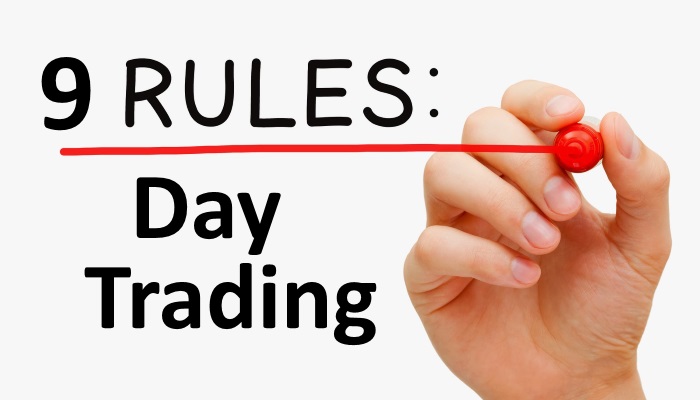
Some traders like to hang a set of their day trading rules next to their trading desk, which always reminds them to stick to their trading rules & plan, and ultimately makes them a better trader.
Whether you are a day trader trading stocks, forex trader, swing trader or any other type of trader, these set of trading rules applies to just about all and will help you become a successful trader.
Below are 9 Golden Day Trading Rules.
Day Trading Rules
Day Trading Rule – #1. Focus on Capital Preservation & Risk Management
One of the most important day trading rules is capital preservation and risk management. Both go hand-in-hand, if you don’t have the proper risk management then you won’t be able to preserve your trading capital.
This should be your number one goal before trying to grow your capital. Without proper risk management and preserving your capital, you can end up losing a lot of money and be out of business as a trader. Once you have mastered this, then profits will take care of itself.
In trading, you have good trades and bad trades, and hopefully, through a consistent approach, you make money overall. Trading is not about trying to hit “home runs” by taking excessive risk on any one position.
You can’t control the markets but you can control your money and your risk on each and every trade that you make. You can preserve capital by the amount of capital you put into a single trade and limiting losses by having stop-losses set in.
As a general rule of thumb, most traders would agree that you should not risk more than 2% of your overall trading capital on a single trade. For example, if you have $25,000 in your trading account, two percent of this amount is $500. That is the maximum amount you can lose on a trade.
That doesn’t mean you should put $25,000 down on a single trade. A good rule is not to put more than 10-20% of your trading capital in a single trade. When trading penny stocks you might want to consider putting less amount of capital into a single trade.
Day Trading Rules – #2. Prepare for The Trading Day
All successful stock traders prepare for their day and they will tell you that the preparation that they have done prior to the trading day is directly correlated with trading success.
Preparing for the day involves a variety of things, such as: being mentally ready, making sure your platform is up and ready to go and doing your homework. You need to find a list of stocks that have the potential to meet your trading strategy criteria. Once you have found a some stocks that meet your criteria, put them on your watch list.
Day Trading Rule – #3. Limit Losses – set a stop order
Before you enter a trade you need to know where you are going to exit if the trade does not go your way. You are not always going to be right on every trade. To limit losses, To limit losses, a stop-loss order should always be in place.
A stop-loss is designed to limit trader’s loss on stock, just in case the stock they are trading goes against them. A stop-loss is a great tool to prevent a small loss from becoming a huge one.
So, what is stop loss order? It is an order placed with a broker to automatically sell or buy (depending on if you are long or short) once the stock reaches a certain price. Setting up stop-loss order at reasonable price limits is a must in trading penny stocks.
So how tightly should a stop loss be set? It all depends on how much you’re willing to lose on that single trade. Many traders set it at a certain percentage and others set it at a particular price point, it all depends on the trader’s trading style. But, a good rule is that you should never lose more than 2 percent of your overall trading capital on any signal trade.
It’s important to have a stop loss in while trading stocks, so that you can cut your losses early and not let small losses become large. Then you are able to concentrate your efforts on another stock that may turn out better.
Day Trading Rules – #4. Lock in your profits
Some stocks are volatile and move fast, therefore you need to lock in your profits. Many traders fail to safeguard their profits and don’t get out at the right time.
There are different strategies to ensure your profits are locked in. You may want to scale out of your position at different price levels or maybe sell at least half of your position. Then wait to take profits on the other half as it reaches another price target and then set a stop order to where you entered the trade.
Another option you can do if you are up in the trade, is put in a trailing-stop. A trailing-stop is typically set at a percentage level below the market price and the trailing-stop price is adjusted as the price fluctuates. A trailing-stop will ensure that profits are locked in.
Day Trading Rules – #5. Understand how to use Margin correctly
Many day traders use margin when they trade stocks. What separates the unsuccessful trader from the successful one is that they understand the risks of using margin and know how to use it correctly.
What is Margin you might ask? Margin allow you to borrow money to buy stock and it basically magnifies how much you can buy in your account. Your broker lends you the money because they want your trading business.
However, trading in a margin account is like a double-edged sword – it can cut both ways. If a stock goes up it will amplify your gains, but can be a disaster if the stock goes the other direction.
Margin is a great tool if you are an experienced trader and have mastered discipline. But, the downside to using margin is that if the stock price decreases, substantial losses can mount quickly and margin can ultimately wipe your trading account quickly if you are inexperienced.
Day Trading Rule – #6. Do NOT over Trade
Do NOT over trade just because you feel like you need to do something or because you want to make more money.
Remember the old saying: “all good things come to those who wait” – well in trading this is very true as it is always best to wait for right trading opportunity to present itself.
You should never force yourself to find stocks to trade, because in the end it may go against you at the worst possible time. Over trading will cause you to lose your focus, discipline and in the end will almost always causes you to lose money because you won’t be concentrating your efforts on finding trades that have greater probability of making you money.
Do not be in too many positions at one time. Also, if you felt like you missed out in a good trading opportunity, don’t try to make up for it by trading in something else. Just learn from it, be patient and remember another trading opportunity will always present itself soon!
The more you trade, the more risk you take. And don’t trade outside of your trading style, just because you want to trade. Just be patient and wait for the right setup that meets your trading criteria.
Day Trading Rules – #7. Always Trade Within Your Own Trading Style & Strategy
Always trade within your own trading style. Do NOT go off testing another trading style or some other strategy. Never jump from one trading style to another.
Keep learning and getting better at one method of trading. Master one style rather than become average at implementing several styles.
If you wonder off from your trading style it will take your focus away from other setups that meet your trading criteria.
Sure, it might work a few times, but trading is all about odds, and odds are if you are doing a trading style that you are not familiar with, most of the time you will end up losing money.
Day Trading Rules – #8. Don’t Be Emotional
Traders might face many emotions from the excitement or thrill of making a great trade, to panic of trying to get out of a trade, or maybe depression after losing money, and many other range of emotions.
One of the keys to become of successful trader is if you master your emotions then you will master the market. In trading you must be logical, not emotional – you must stick with your trading system and rules and be disciplined. Remember, trading is a business and you must treat it like one.
Day Trading Rule – #9. Keep a Trading Journal
When you trade a stock, you should always document your trade, thoughts and experiences in a trading journal. A trading journal is a great tool so that you can go back and review trades after the fact and analyze what worked and what didn’t.
For example, you can write down your entry & exit points in a trade, write down the mistakes you’ve made, as well as things that you did right in that trade. By referring to a trading journal, a trader can learn from their successes and failures, and ultimately help improve you as a trader.



